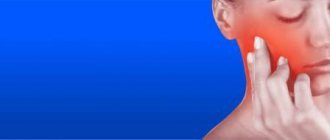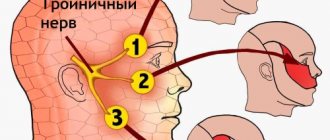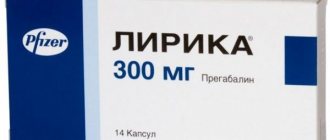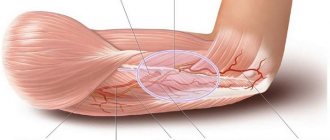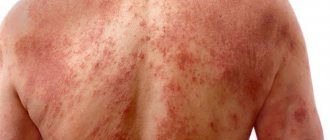Symptoms and treatment of brachial neuralgia
A rather painful disease, the main symptom of which is severe pain in the arm, is called brachial neuralgia; its symptoms and treatment depend on the cause.
Most often, the background for sharp pain in the shoulder and arm is prolonged physical activity, past infections, and osteochondrosis.
The immediate cause of neuralgia is compression (squeezing) of the nerve by spastically compressed and inflamed muscles, tendons or deformed intervertebral discs.
Clinical manifestations
In most cases, it is difficult to raise your hand up or move it to the side.
Factors that trigger the pathological process are:
- strenuous physical activity;
- trauma - severe bruise, sprain, dislocation;
- severe intoxication - poisoning or alcoholism;
- a sharp decrease in immunity, for example, due to acute respiratory viral infections or severe stress;
- systemic health disorders due to endocrine disorders - diabetes, thyroid disease, pituitary gland;
- pathologies of the vascular system.
In most cases, the working hand is affected - the right, and the left in left-handed people. The nature of neuralgia depends on which roots of the nerve segments are pinched.
There may be sudden paroxysmal burning or piercing pains, radiating to the back, side, chest, periodically increasing and temporarily disappearing, or constant painful aching sensations with almost no light intervals.
With deep localization of the lesion, the symptoms can be so alarming that they suggest a developing heart attack or gastric ulcer.
Often the pain is accompanied by local tissue swelling, increased sweating, stiffness in the shoulder area, impaired mobility, involuntary twitching or tremors. It is difficult to raise your arm up or move it to the side. The skin on the affected area turns red. Any, even the lightest touch to a sore spot causes severe discomfort.
During periods of calm attacks, paresthesia is possible - a feeling of crawling, trembling, tingling, slight numbness, weakness in the affected arm and other neuralgic symptoms.
There is sharp pain when pressing with a finger in the armpit or on the border of the biceps and triceps in the middle of the shoulder - at the so-called Valle points.
There are primary and secondary neuralgia of the shoulder joint.
In the first case, the pathology is limited to pain, local inflammation, may be accompanied by fever, increased temperature, is not complicated by edema and is quite easily reversible, its cause is often simple hypothermia. In itself, this condition causes more physical pain than serious health hazard.
Secondary brachial plexus neuralgia is a symptom of other, more serious disorders in the body, for example, osteochondrosis, and cannot be completely cured without treating the underlying disease.
Diagnosis and treatment
Treatment of brachial neuralgia should be carried out at the first signs of the disease, and not only because it causes severe discomfort. Long-term lack of therapy aggravates the condition of the pinched nerve, intensifying pain attacks, provoking the further development of polyarthritis or neuritis - a serious lesion with impaired function of the shoulder joint, including paralysis.
Diagnosis is complicated by the similarity of symptoms with a number of other diseases and requires differentiation from manifestations of cervical osteochondrosis and neuritis.
In addition to collecting anamnesis, instrumental methods are used:
- ultrasonography;
- radiography;
- magnetic resonance and computed tomography.
Treatment of brachial neuralgia has several goals: to relieve a person from physical suffering, to restore normal mobility to the limbs, and to eliminate the root causes that caused the disease.
Complex therapy is used:
- The pain syndrome is relieved by non-steroidal anti-inflammatory drugs. Drugs containing ibuprofen and analgesics are used: Ibuklin, Nurofen, Diclofenac, Ketanov, Next, Solpadeine. Tablet analgesics are effective for pain of mild and moderate intensity, but for severe acute attacks they may not be effective enough. In addition, long-term use of painkillers negatively affects the condition of the liver and kidneys, causing disruption of their functions.
- To ensure a lasting therapeutic effect, oral administration of analgesics is combined with local treatment with anti-inflammatory and warming ointments and gels - Finalgon, Viprosal, Capsicam. In cases of persistent unbearable pain, novocaine blockade is used.
- Since neuralgia of the shoulder joint causes prolonged severe physical suffering to the patient, which inevitably affects the psycho-emotional background and mood, treatment is accompanied by the use of mild antidepressants.
- As part of complex therapy, injections of B vitamins are prescribed, which are necessary to stimulate intracellular metabolism in tissues.
- Physiotherapy plays an important role in the treatment of shoulder neuralgia. Acupuncture, ultrasound treatment, electrophoresis, laser therapy have an analgesic and targeted restorative effect, help eliminate congestion in the affected area, relieve swelling, which allows you to reduce the use of analgesics. Primary neuralgia can be completely cured after undergoing a course of physiotherapy.
- Therapeutic exercise is necessary to strengthen the muscular and ligamentous apparatus and restore joint mobility. Exercise therapy exercises are prescribed by doctors; after several training sessions on an outpatient basis, they can be performed at home. In order to ease the load on the sore joint, bandages and bandages that fix the arm can be used.
- With the approval of a doctor, you can supplement treatment with traditional medicine: rubbings based on hot pepper, mustard, bee venom, and medicinal herbs.
The most thorough treatment of secondary neuralgia of the shoulder joint will not have the desired effect if the underlying disease that caused it is not treated. Self-diagnosis based on symptoms alone is also unacceptable: it is easy to cause severe nerve damage. All therapeutic measures must be prescribed by doctors and carried out under medical supervision.
Symptoms and treatment of brachial neuralgia Link to main publication
Source: //hondrozz.ru/oslozhneniya/nevralgiya/plechevogo-nerva-simptomy-lechenie.html
Shoulder and arm hurt – is this neuralgia?
With neuralgia, the arm and shoulder not only hurt - they gradually lose their functionality. Characteristic signs of damage to the nerve fiber structure appear. It consists of motor (motor) and sensory (sensory) axons. In this way, the actions and functioning of the muscular system are controlled. Sensitive types of axons transmit information about external influences through the spinal cord to the brain. In the opposite direction, a signal is transmitted along the motor (motor) nerve fibers about the need to bend or straighten a part of the limb.
If a nerve fiber is damaged, signals may not pass through or pass through in a distorted form. This causes pain, paresthesia, decreased or complete absence of skin sensitivity, muscle weakness and atrophy.
If the shoulder and arm hurt with neuralgia, then the localization of the inflammatory process is located at the level of the radicular nerves or branches forming the plexus. Often, this condition signals compression of the radicular nerves against the background of degenerative destruction of the intervertebral discs.
With neuralgia, pain in the shoulder area must also be differentiated from the destruction of articular tissues. With deforming osteoarthritis of the shoulder joint, capsulitis, destruction of the labrum, tendinitis, bursitis and a number of other diseases, acute pain syndrome also occurs. Therefore, for differential diagnosis, it is important to conduct a full radiographic examination. Pictures are taken of the shoulder, forearm, all major joints and the cervicothoracic spine. Based on the results of the examination, it is possible to detect the place where compression or inflammation of the nerve fiber occurs.
If your shoulder hurts due to neuralgia, then you should not engage in self-diagnosis and treatment. Seek medical advice from an experienced physician. Without its help, it is difficult to identify and eliminate the potential cause of such a complex of symptoms.
Ulnar neuralgia: symptoms and treatment methods. How to treat neuralgia of the hands
Neuritis is a disease in which part of the nervous system is affected and inflammatory processes begin. The disease can affect one or several nerves. In this case, the extent depends on the pathology.
Regardless of which nerve is affected, there are basic signs such as:
- sensation of pain near the nerve endings;
- impaired sensitivity;
- muscle weakness and pain under the shoulder blade.
One way or another, many people know about ulnar nerve neuritis, and not by hearsay, since this ailment is considered very common among such diseases.
About the anatomy and causes of the disease
The reasons that cause this condition are varied, since there are places on the arm along the ulnar nerve that are often compressed.
It is known that the ulnar nerve is a nerve of the brachial plexus.
It enters the arm directly from under the muscle fossa, then passes through the intermuscular septum somewhere in the middle of the shoulder, and passes into the osteofibrous canal.
In addition, it is located close to the bone formations, which causes compression of the nerve fibers in this place. This can be felt simply by hitting some part of the elbows.
After the nerve exits the canal, it is directed to the side between the muscles of the forearm, and then divides into the dorsal branch of the hand and the palmar branch, where it also lends itself to compression.
In what cases can this nerve be damaged:
- in the presence of a fracture or dislocation of the shoulder, hand or forearm;
- if there is compression of the fibro-osseous canals, including the cubital canal.
Most often, injury occurs through compression, which may not necessarily be sudden or acute. As a rule, the development process occurs at a slow pace, as a result of prolonged exposure to a traumatic nature. For example, this could be frequent bending at a given joint or working on a machine, at a desk or workbench, and other similar situations.
In addition to the above reasons, this disease can appear if the nerve is compressed by a tumor or enlarged lymph nodes, or with arthrosis of the elbow joint, as well as joints on the wrist.
Other reasons include any infection or hypothermia, diabetes, damage to nerve tissue by toxins, as well as chronic alcohol consumption.
Treatment of neuralgia in the acute stage
Pain in the shoulder joint in the acute stage cannot be eliminated with medications alone. Treatment in this case should be comprehensive.
Painkillers
Among the huge range of analgesics, preference for shoulder joint neuralgia is given to traditional ones - analgin, spasmalgon, baralgin. If these drugs are not enough to relieve pain, non-steroids may be additionally prescribed, but for a short course. Neuralgic pain is well relieved by local distractions - mustard plasters, plasters, compresses.
Nonsteroidal anti-inflammatory drugs
In combination with analgesics, NSAIDs are used, which perform a dual role - they relieve pain and eliminate the inflammatory process. Neuralgia of the arm and shoulder joint is treated with drugs such as Ibuprofen, Sulindac, Indomethacin, Ketorolac.
Important! All drugs related to NSAIDs are strong chemical reagents, they can treat one thing, but harm another. For example, side effects of NSAIDs include kidney problems and irritation of the stomach lining.
In order not to harm the body and cure neuralgia, the option of using a non-steroidal anti-inflammatory drug should be prescribed by a doctor.
Ointment
Ointment is used to treat neuralgia.
The main task of this tool is to:
- a warming effect that acts on the ligaments and relaxes them;
- stimulating blood circulation;
- increasing the elasticity of damaged ligaments;
- activation of the metabolic process.
Throbbing pain in the back of the head is a symptom that cannot be ignored
The composition of the medicinal ointment includes painkillers and anti-inflammatory components. Ointments prepared using bee or snake venom or capsicum have a good effect. Doctors recommend using ointments such as Myoton, Finalgon, Viprosal, Apizartron.
Before using any of the variations of medicinal ointment, you must carefully read the instructions for use. Most warming and anti-inflammatory ointments cannot be used by women during pregnancy or lactation.
Injections
If tablets, ointments or gels do not bring the desired effect and do not relieve the patient from the unpleasant symptoms of the disease, then treatment of neuralgia continues with injections. Injections are most often used in cases where the patient is suffering from severe and unbearable pain. Injections such as Baralgin, Ketorolac, Voltaren have a therapeutic effect.
Source: //pro-acne.ru/pro-sustavy/nevralgiya-ruki-simptomy-loktevogo-nerva-i-ego-lechenie.html
Neuralgia of the brachial nerve (plexus, joint) of the hand: symptoms and treatment
Neuralgia caused by muscle tension is a frequent and quite common phenomenon, especially in older and elderly people.
The disease is insidious, develops quickly, becomes chronic, and there is a risk of serious damage to the nerves themselves, which ultimately affects the functioning of the joints.
The causes and main manifestations of the pathology, stages of development, modern methods of differential diagnosis and treatment of neuralgia of the brachial nerve, or as it is also called - the shoulder joint of the arm or plexus, will be discussed in the article.
What it is? ICD-10 code
Anatomically, the nervous system is the most important component of the human body ; it is responsible for the coherence and consistency of the work of other organs and vital systems.
There are some pathologies that are directly related to damage to the nerve trunks - these are various neuralgia (occipital, trigeminal, external femoral nerve).
Brachial neuralgia - spasms of the shoulder muscles , pinching and damage (in clinical cases) to the peripheral nerve processes or roots of the brachial plexus.
The plexus of nerves emerges from the cervical spine and is located at the level of the joint (at the junction of the clavicle, the process of the scapula and the head of the humerus). This plexus then branches throughout the arm.
The essence of the interaction between the nervous and muscular systems is simple - the branches of the brachial plexus send electrical signals to the muscle, which contracts under the influence of this signal. Any movement is a muscle contraction.
With neuralgia, the inflammatory process only compresses, but does not damage the nerve fibers.
According to the international classification of diseases (1999) - ICD-10 - the disease is assigned the code: G54.0, denoting diseases of the nervous system, class No. 6. This pathology can also be classified as class M, No. 13 (diseases of the musculoskeletal system), depending on the root cause of its origin. If the diagnosis is “blurred”, specialists use coding M79.2 (subsection of unspecified neuralgia).
Causes
By origin, brachial neuralgia can be:
- primary (essential) - clinical examination did not reveal any associated diseases affecting the inflammatory process;
- secondary (symptomatic) - tumors and inflammations are detected that negatively affect the structure of nerve fibers.
Main reasons:
- age-related changes in the body (according to statistics, pathology is more common in elderly patients);
- birth injuries (during pathological childbirth, damage to the nerve trunk in a newborn is possible);
- severe and systematic hypothermia (sharp fluctuations in temperature critically reduce immunity and cause inflammation);
- various viral, fungal, bacterial infections, complications of colds and flu - the cause of primary neuralgia;
- poisoning of the body (toxins and chemicals can be causative agents of the disease);
- tumors, including cancer - any neoplasm causes severe compression of nerve branches (oxygen deficiency in tissues provokes cell death, impulses become weak or disappear altogether);
- shoulder injuries - dislocations, fractures, bruises, micro tears of the tendon, damage to muscles and ligaments (with the rapid expansion of blood vessels, inflammation and swelling occur);
- improperly applied tourniquet, plaster, long-term use of crutches;
- diseases of the vascular bed (poor patency, blood clots, plaques) - a violation of the exchange between tissue fluid and blood causes excess (accumulation) of fluid, causing edema;
- heavy physical activity (athletes, hard work) causes swelling, spasms of muscles and ligaments;
- cervical and thoracic osteochondrosis, vertebral hernia (bone tissue, disc deformation damages brain vessels, disrupts blood flow, pinches nerves);
- diabetes mellitus, chronic diseases of the stomach and duodenum (ulcers, colitis), hormonal imbalance (metabolic disorder) causes tissue inflammation, which becomes an indirect cause of neuralgia;
- against the background of stress, pathology may appear;
- weakened immunity.
Clinical picture: manifestations and symptoms
Most often, brachial neuralgia develops unilaterally, on the right side.
If the disease is caused by hypothermia or is a consequence of influenza, ARVI, acute respiratory infections and other infections , it manifests itself in an acute form:
- pain in the shoulder and neck appears immediately;
- accompanied by general weakness and fever;
- temperature rise is possible.
For injuries:
- pain increases gradually;
- the pain subsides over time;
- slight stiffness when moving the arm and shoulder;
- partial numbness.
The duration of attacks varies - from 2-3 seconds (shooting pain) to several hours (dull, aching, obsessive).
In the advanced stage:
- constant pain (discomfort both during the day and at night);
- sweating;
- redness and severe burning of the skin;
- tearfulness;
- convulsions are possible.
General symptoms:
- muscle spasms (periodic involuntary twitching, sometimes lasting 1-2 minutes);
- as the disease develops, swelling of muscle tissue is observed;
- aching constant pain of an exhausting nature occurs;
- attacks of unbearable, burning pain occur spontaneously, periodically.
It is difficult to independently determine the original source, since it can hurt and radiate in different areas.
Possible patient complaints, depending on the affected area:
- Bottom form – severe pain is concentrated in the inner surface of the shoulder and forearm area, manifests itself when moving.
Partial loss of sensitivity is possible (the nerve fibers of the plexus are responsible for tactile and temperature sensitivity).Impairment of fine motor skills and decreased muscle tone (difficulty forming fingers into a fist or holding small objects) are also possible.
- Upper form – pain above the collarbone, radiating to the forearm area. Sensation is lost in the outer part of the forearm. The mobility of the arm is limited, a sharp cutting pain occurs when moving, it is difficult to bend the arm at the elbow and straighten the shoulders.
- The total form is the most dangerous; the general symptoms include fever, drowsiness, weakness, possible nausea and lack of appetite. This type of neuralgia often occurs against the background of poisoning and weakened immunity.
In an advanced state, the pain syndrome becomes excruciating, spreads to the area of the shoulder blade and chest, and radiates to the back.
Diagnostics
The first thing the patient needs to do is contact a neurologist or kinesiologist . Only a specialist can make a presumptive diagnosis and find the cause of inflammation based on:
- initial examination taking into account complaints and characteristic manifestations of the disease;
- medical history (lifestyle, activity, concomitant diseases, etc.).
A biochemical blood test is required, revealing:
- leukocyte count;
- erythrocyte sedimentation rate;
- blood protein ratio;
- exclusion of anemic condition.
To exclude other diseases and pathological neoplasms (stomach ulcer, renal pathologies, heart failure, vertebral hernia, etc.), the patient is prescribed additional differential diagnostics:
- MRI is a modern method that studies the structure of the vertebrae and tissues and detects neoplasms.
- Electroneuromyography - using myographs, the condition of the muscles and peripheral nervous system is studied (conductivity of the electrical impulse, the exact location of the affected area).
- X-rays monitor the displacement of the vertebrae, the presence of bone growths that clamp the nerve endings.
- Ultrasound allows you to assess the condition of blood vessels, and examines the movement of blood (to exclude vascular pathologies).
- In clinical cases, a spinal cord puncture is performed (the presence of harmful microorganisms causing pathology).
Features of therapy
The choice of treatment methods and techniques is directly related to the cause of the disease.
At the first stage, brachial neuralgia can be treated conservatively:
- analgesics (Ibuprofen, Tempalgin, Ketoprofen) are prescribed to relieve pain and inflammation;
- for severe pain, injection blockade with Novocaine is used;
- to reduce swelling, diuretics (Veroshpiron) are prescribed;
- anti-inflammatory ointments are used (Fastum-gel, Viprosal);
- only after the swelling has been removed can you use warming gels (Capsicam, Finalgon), they restore the functioning of muscle tissue;
- antibiotics are prescribed according to indications;
- to fix the arm, special splints and bandages are used;
- support of the body is required (B vitamins).
The therapy lasts 2 weeks; with proper treatment, the patient returns to a full life quite quickly.
In the absence of positive dynamics, surgical methods are recommended:
- neuroexeresis;
- neurotomy;
- tractotomy.
Application of acupuncture
After general treatment, the specialist recommends undergoing a recovery course (electropheresis, massage, mud baths, etc.)
Acupuncture – a combination of reflexology and acupuncture – impact on biologically active points (a complex of acupuncture, massage and warming).
The peculiarity of the method is that tissue restoration occurs faster, the risk of complications and recurrence of the disease is reduced.
Traditional methods
It should be noted that any alternative medicine recipes for neuralgia can only be used as an additional treatment:
- Tincture of black elderberry flowers not only relieves inflammation and pain, but normalizes metabolic processes. The preparation method is simple: 2 tbsp. l. crushed raw materials are steamed with boiling water (1 l), infused for 2-3 hours. Take 100 g 3 times. per day after meals for 2 weeks. You can add honey to the decoction.
- with a tincture of crushed raspberry stems and leaves . Recipe: pour 250 g of boiling water 1 tbsp. l. raspberries, simmer in the oven or over low heat for 40 minutes, cool. Take 3 tbsp. l. infusion 3 r. a day before meals (half an hour). The course of treatment is at least 2 – 3 months.
- A decoction of fireweed leaves is a natural analgesic that relieves pain and inflammation. The tincture can be prepared in a thermos - 2 tbsp. l. pour 0.5 liters of boiling water over the raw material and leave for a day. Take 50 g 3 times. per day before meals for a month.
- A heat compress from flax seeds is applied topically: boil the seeds in a gauze or fabric bag for 2 minutes, cool to a comfortable temperature so as not to cause a burn. A warm compress is applied to the sore spot and covered with an insulating cloth or towel. It is better to use before bedtime.
- For systemic pain, a decoction of the centaury herb . Pour 1 cup boiling water over 3 tbsp. l. chopped grass. Leave for 2 - 3 hours. Take 3 tbsp. l. infusion 3 r. per day before meals for 10-14 days.
Possible complications, prognosis and prevention
If you consult a doctor in a timely manner, the prognosis is always positive.
Self-medication or ignoring the first symptoms can lead to complications:
- neuralgia of the brachial nerve takes on a chronic form and becomes fixed;
- the disease degenerates into plexitis (the nerve fibers of the brachial plexus are damaged);
- risk of developing Horner's syndrome (affects the eyeball);
- significant damage to the nerve plexuses leads to loss of sensitivity and decreased mobility;
- in critical cases, paralysis of the arm and complete muscle atrophy are possible.
It is known that preventing a disease is easier than completely eradicating it.
Prevention:
- prevent hypothermia of the body;
- exclude situations of injury (ice, moderate sports activities);
- timely treatment of viral infections;
- balanced diet (vitamins, meat, dairy products);
- Hardening, sports and a healthy lifestyle strengthen the immune system and resist any viruses and infections.
In conclusion, brachial neuralgia should be treated immediately . Only in this case is a complete recovery guaranteed without complications or relapses.
Source: //nerv.guru/zabolevaniya/nevralgiya/vidy-n/plechevogo-nerva.html
What are the symptoms of neuralgia in the shoulder joint?
With this disease, the symptoms are not varied. First of all, this is, of course, pain, which can have varying intensity and character. So, the pain can be aching, dull, sharp, burning, or even appear periodically in the form of attacks. At the same time, during such attacks of pain, sweating increases, muscle twitching appears, and pallor or redness of the skin appears.
Are there spasms in your muscles? Most likely this is the first sign of neuralgia
In most cases, the appearance of the pain syndrome itself is preceded by the appearance of spasms in the muscles. They can occur for a variety of reasons - due to injuries, hypothermia, awkward movements or heavy physical activity, colds or infections, etc. As a result, overstrain occurs in the muscles, to which the muscles react with a reflex contraction - a spasm. Next, swelling of the muscle tissue develops, resulting in compression of the nerve endings and pain.
In general, we can say that with neuralgia, paroxysmal pain appears in the shoulder or arm. In some cases it can be constant, in others it can disappear completely between attacks. In the vast majority of cases, pain spreads throughout the arm, without a specific localization, but in some cases the pain can be localized in the forearm or shoulder, limited to the area where the irritated plexus nerves are located. In this case, neuralgia is almost always one-sided.
A very unpleasant moment can be the appearance of various neurological symptoms - sensory disturbances, weakened reflexes, etc. This may indicate the development of neurosis of the shoulder joint, i.e. that the inflammation “spread” to the nerve itself.




